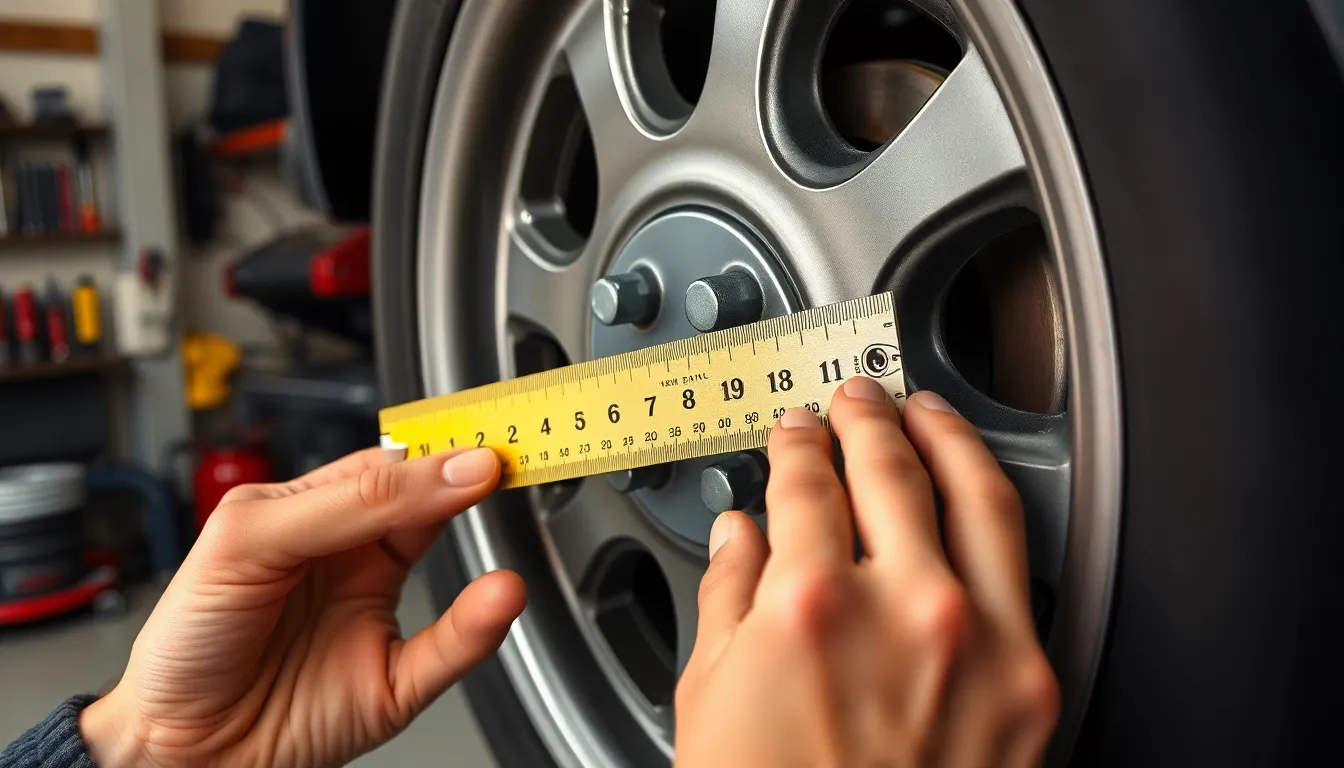Getting the right wheels for your vehicle isn’t just about style – it’s about safety and proper fitment. We’ve all been there: you find the perfect set of wheels online only to discover they don’t match your car’s bolt pattern. That’s where knowing how to measure your wheel lug pattern becomes crucial.
Your wheel’s bolt pattern determines whether aftermarket wheels will fit your vehicle correctly. This measurement affects everything from wheel alignment to your safety on the road. Without the right bolt pattern you’ll face mounting issues vibrations and potentially dangerous driving conditions.
We’ll walk you through the simple process of measuring your wheel lug pattern accurately. Whether you’re upgrading to performance wheels or replacing damaged ones understanding this measurement saves you time money and frustration. Let’s jump into the straightforward methods that’ll help you get the perfect wheel fitment every time.
What Is a Wheel Lug Pattern and Why It Matters
A wheel lug pattern represents the exact arrangement of bolt holes on your vehicle’s wheel hub and the corresponding holes on your wheels. This pattern consists of two critical measurements: the number of bolt holes and the diameter of the circle that passes through the center of each hole.
Automotive manufacturers design lug patterns with precise specifications that vary significantly across different vehicle makes and models. The pattern determines which wheels can physically mount to your vehicle’s hub assembly. Common lug patterns include 4×100, 5×114.3, 6×135, and 8×165.1, where the first number indicates the bolt count and the second represents the bolt circle diameter in millimeters.
Safety Implications of Correct Lug Pattern Matching
Mounting wheels with incorrect lug patterns creates dangerous driving conditions that compromise vehicle safety. Mismatched patterns prevent proper wheel centering on the hub, causing vibrations that worsen at higher speeds. These vibrations stress suspension components and create uneven tire wear patterns that reduce tire lifespan by up to 40%.
Improperly fitted wheels also affect braking performance since the wheel’s mounting surface doesn’t align correctly with the brake rotor. This misalignment increases stopping distances and generates excessive heat that can warp brake components.
Performance and Handling Considerations
Correct lug pattern matching ensures optimal wheel balance and vehicle handling characteristics. Wheels that mount flush against the hub maintain the manufacturer’s intended suspension geometry and steering response. This proper fitment preserves your vehicle’s designed handling characteristics and prevents premature wear on steering components like tie rods and ball joints.
Incorrectly mounted wheels alter the vehicle’s track width and can change the scrub radius, affecting steering feel and stability during cornering. These changes become particularly noticeable during emergency maneuvers when precise vehicle control becomes critical for safety.
Legal and Warranty Implications
Using wheels with incorrect lug patterns can void your vehicle’s warranty and create liability issues in accident situations. Insurance companies may deny claims if they determine that improper wheel fitment contributed to an accident. Also, some states have vehicle inspection requirements that include wheel and tire fitment verification.
Aftermarket wheel manufacturers typically void their warranties when their products are installed on vehicles with non-matching lug patterns. This warranty exclusion leaves vehicle owners responsible for any wheel failures or related damage costs.
Tools Needed to Measure Your Wheel Lug Pattern
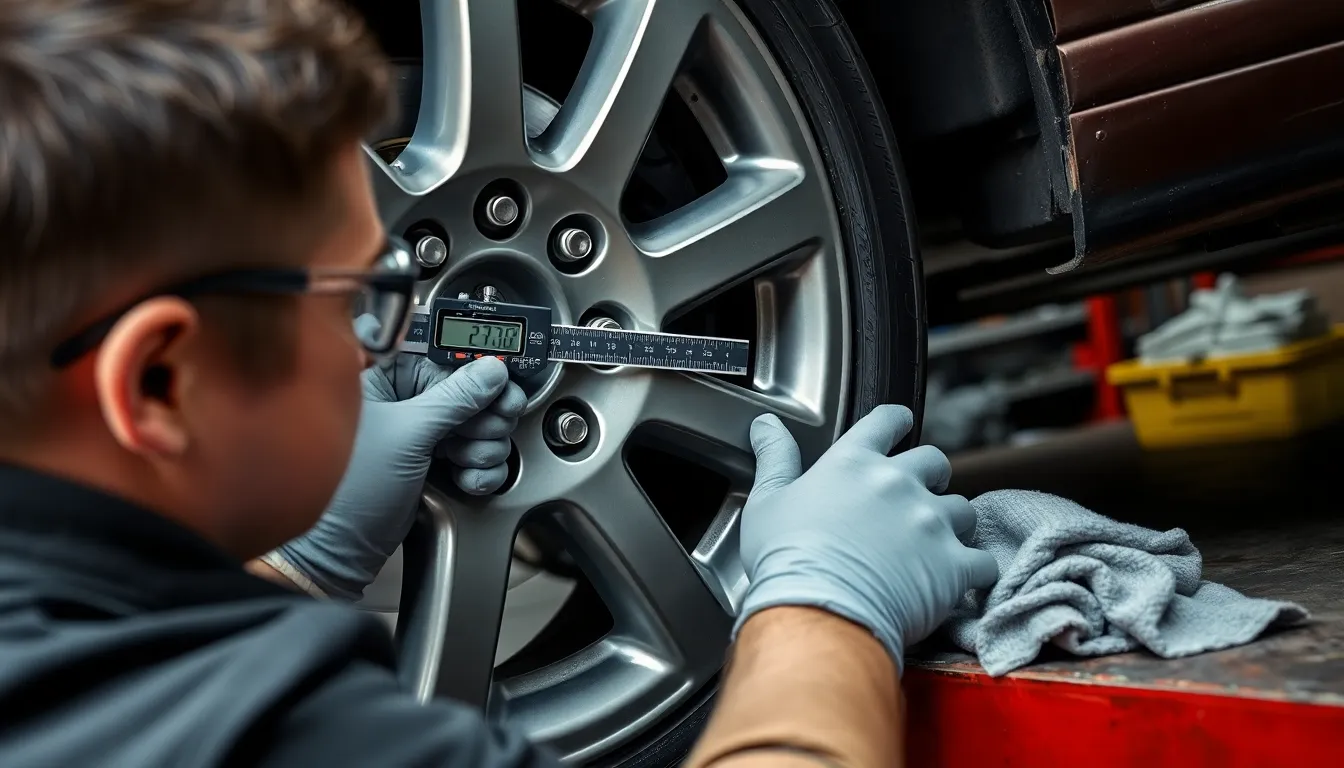
Measuring your wheel lug pattern accurately requires exact tools that ensure precise measurements. We recommend gathering these essential items before starting the measurement process.
Ruler or calipers serve as the primary measurement instrument for determining lug pattern dimensions. Calipers provide superior accuracy compared to standard rulers since they can measure both internal and external distances with millimeter precision. Digital calipers offer the most reliable readings and eliminate human error in interpreting measurement marks.
Access to your vehicle’s wheel becomes necessary for taking direct measurements from the lug holes. We can measure the pattern while the wheel remains mounted on the vehicle or after removing it completely. Removing the wheel often provides easier access and more accurate measurements since we can position our measuring tools without obstruction.
A bolt pattern guide or reference chart helps confirm our measurements against standard automotive specifications. These guides contain common lug patterns for different vehicle makes and models, allowing us to verify our measurements match recognized industry standards. Many guides include both metric and imperial measurements for comprehensive reference.
A flashlight or work light improves visibility when measuring lug holes, especially in poorly lit garage environments. Proper lighting ensures we can clearly see the center points of each lug hole for accurate measurement placement.
Safety equipment including gloves and safety glasses protects us during the measurement process. Gloves provide better grip on measuring tools while safety glasses shield our eyes from debris that might fall from the wheel area.
A clean cloth or brush removes dirt and debris from lug holes before measurement. Clean holes allow our measuring tools to sit properly in the center points, resulting in more accurate readings.
How to Count Your Vehicle’s Lug Nuts
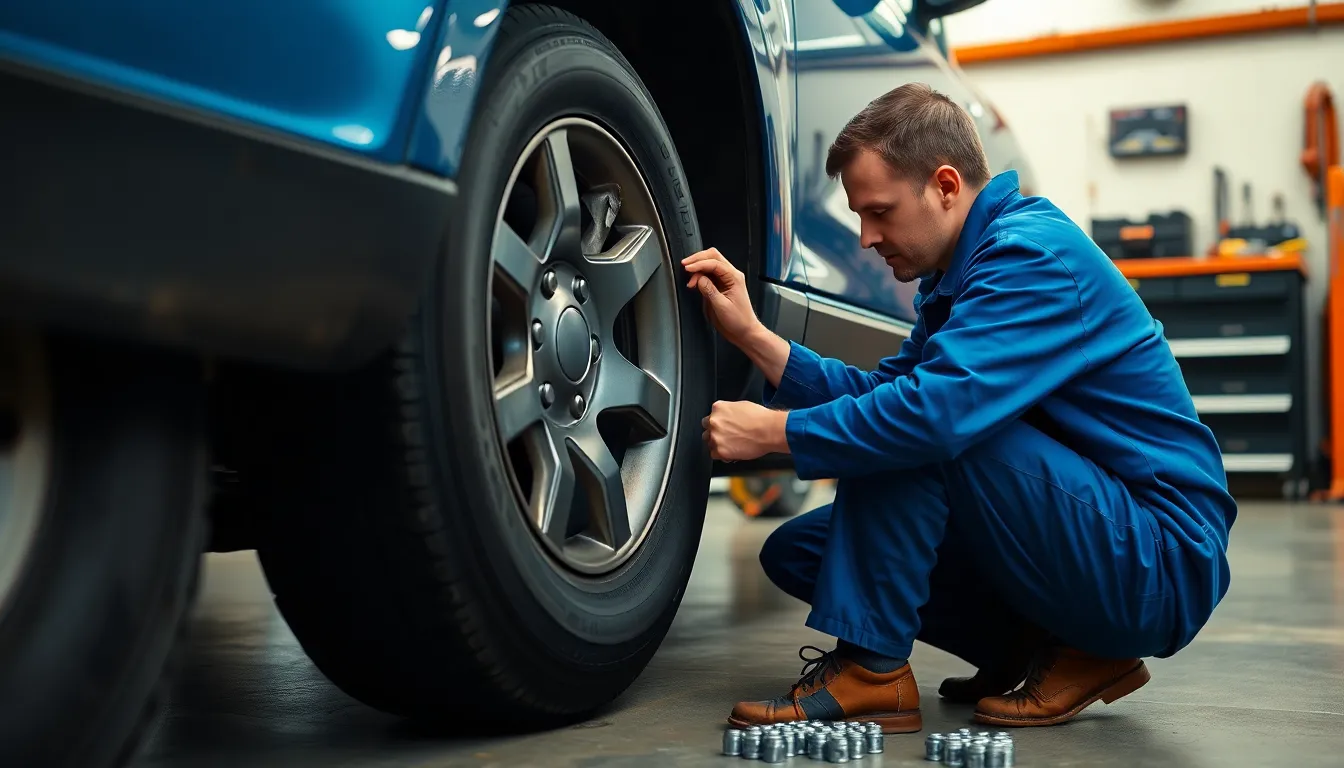
Counting lug nuts provides the first critical component of your wheel’s bolt pattern measurement. We locate the wheel by positioning ourselves where we can clearly observe all mounting points around the hub assembly. Most automotive wheels feature either 4, 5, or 6 lug nuts, though some vehicles use different configurations depending on their exact design requirements.
Accessing Your Wheel for Counting
Removing the wheel offers the clearest access to count lug nuts accurately. We can also perform this count with the wheel mounted if removal isn’t practical for your situation. Clear visibility of all lug positions ensures we don’t miss any mounting points during our assessment.
Identifying Standard Lug Configurations
Common lug patterns include these standard arrangements:
- 4 lug wheels – Found on compact cars and lightweight vehicles
- 5 lug wheels – Standard configuration for most passenger cars and light trucks
- 6 lug wheels – Typical for pickup trucks and larger SUVs
- 8 lug wheels – Heavy duty trucks and commercial vehicles
Counting Methodology
Starting from any lug nut position, we count clockwise around the wheel hub until we return to our starting point. Double checking our count prevents errors that could affect subsequent measurements. Each lug nut represents one hole in the bolt pattern, making this count the first number in your wheel’s bolt pattern specification.
We observe each mounting point carefully since some wheels may have decorative caps or covers that could obscure actual lug nuts. Removing any wheel covers or center caps reveals all functional lug nuts for accurate counting.
| Vehicle Type | Typical Lug Count | Common Applications |
|---|---|---|
| Compact Cars | 4 | Economy vehicles, small sedans |
| Standard Cars | 5 | Mid size sedans, crossovers |
| Trucks/SUVs | 6 | Pickup trucks, large SUVs |
| Heavy Duty | 8 | Commercial trucks, heavy vehicles |
Measuring 4 and 6 Lug Patterns
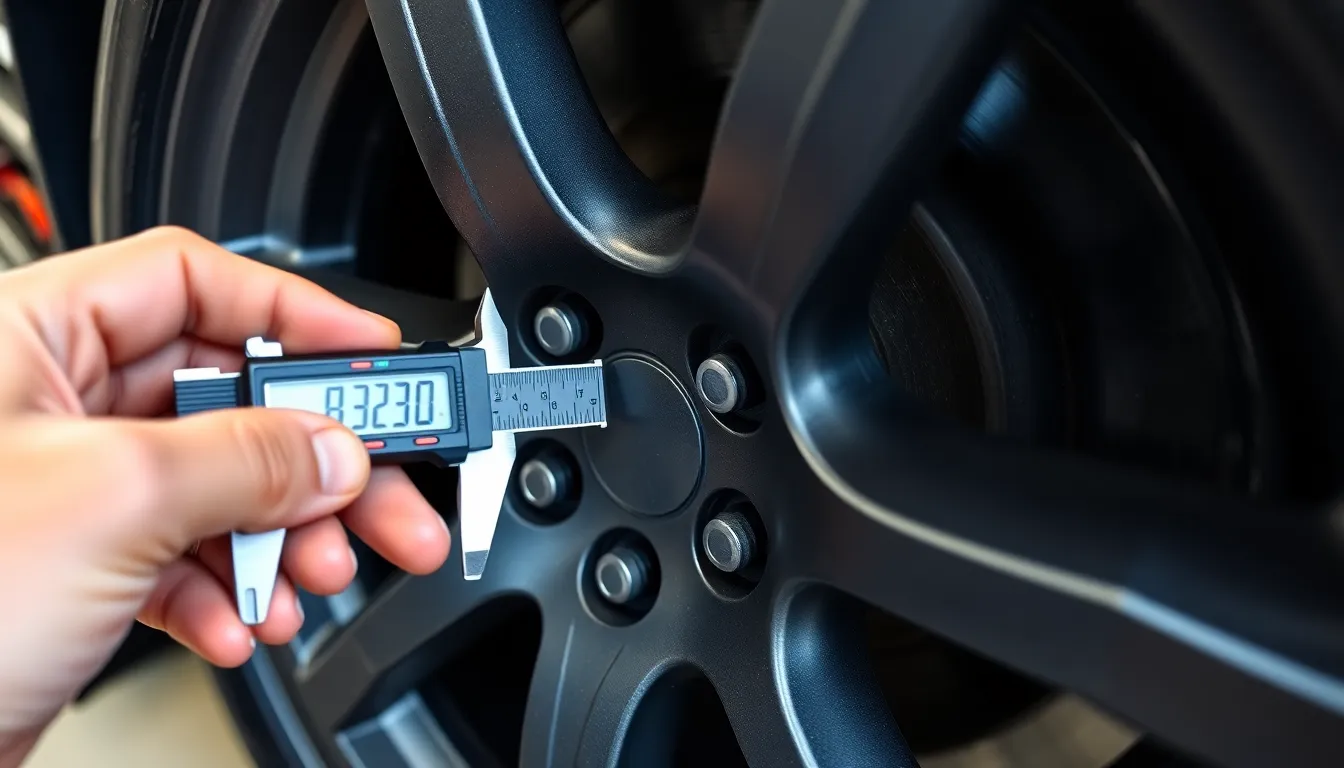
Measuring even-numbered lug patterns (4, 6, or 8 lugs) follows a straightforward process because the lugs sit directly opposite each other. This symmetrical arrangement allows us to take a single direct measurement across the wheel’s center.
Center-to-Center Measurement Method
Finding two lug holes positioned directly opposite each other serves as our starting point for this measurement technique. We measure the distance from the center of one lug hole to the center of the opposite lug hole to determine the bolt circle diameter (BCD).
Positioning your measuring tool across the wheel’s center ensures accuracy when taking this measurement. Digital calipers provide the most precise readings, though a standard ruler works for basic measurements.
Common measurements for even lug patterns include:
| Lug Count | Measurement (mm) | Pattern Notation |
|---|---|---|
| 4 | 100 | 4×100 |
| 6 | 139.7 | 6×139.7 |
| 8 | 165.1 | 8×165.1 |
Recording this center-to-center measurement gives us the complete bolt pattern specification when combined with our lug count from the previous step.
Using the Bolt Circle Formula
Calculating the bolt circle diameter using the mathematical formula provides an alternative method for verification purposes. The formula uses the distance between two adjacent lug holes (d) and the number of lugs (n):
D = d ÷ sin(180°/n)
Measuring the distance between adjacent lug holes rather than opposite holes gives us the “d” value for this calculation. We then divide this distance by the sine of 180 degrees divided by the number of lugs.
Applying this formula to a 4-lug wheel with 70.7 mm between adjacent holes: D = 70.7 ÷ sin(45°) = 100 mm. Direct measurement typically provides sufficient accuracy for practical wheel fitting purposes, making the formula method optional for most applications.
Cross-referencing formula results with direct measurements helps confirm our readings and catch potential measurement errors.
Measuring 5 Lug Patterns
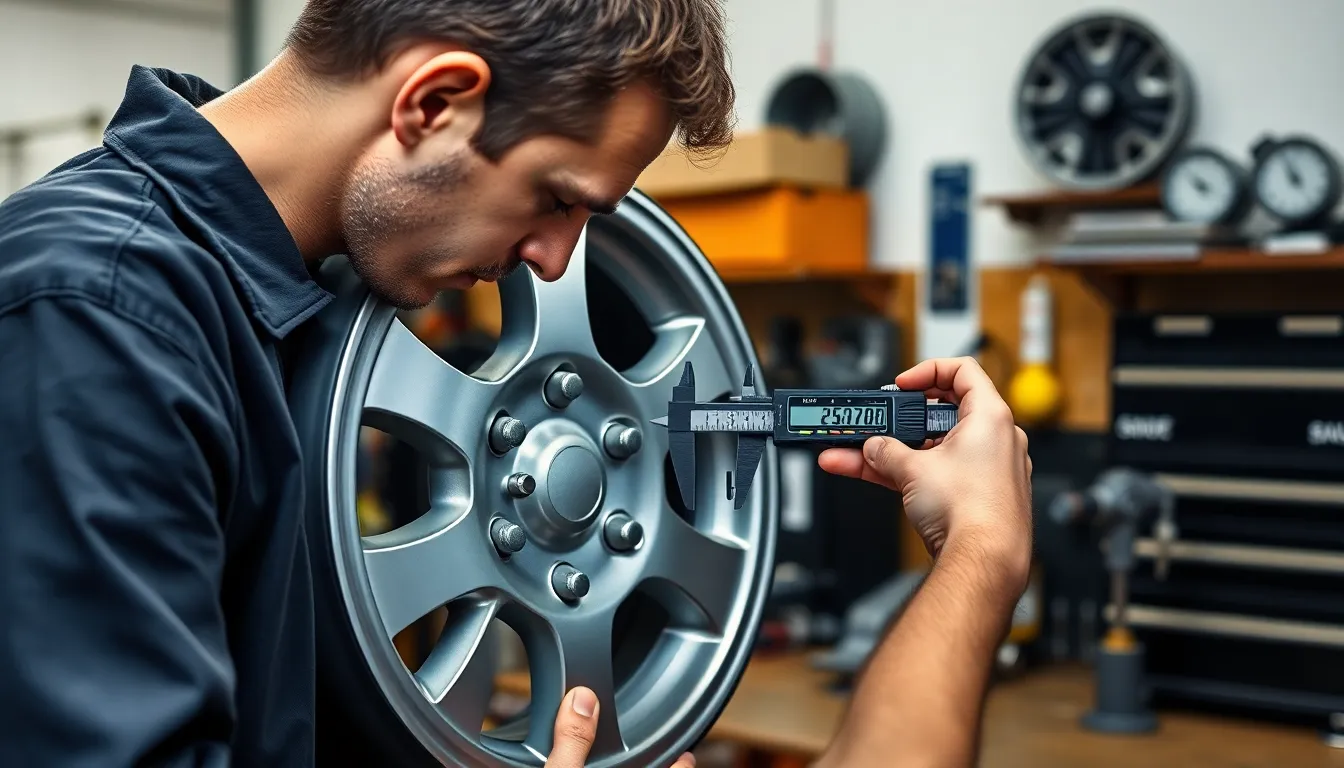
Measuring 5 lug patterns requires a different approach since there’s no directly opposite lug hole to measure between. We recommend the skip-one method as the most accurate technique for determining the bolt circle diameter on 5 lug wheels.
Skip-One Method for 5 Lug Wheels
We select any lug stud as our starting reference point for this measurement technique. Skipping the adjacent lug, we move to the next stud and measure from the center of our starting lug to the outer edge of the farthest lug hole. This distance gives us the bolt circle diameter directly.
Recording the measurement involves noting both the number of lugs and the diameter measurement. A measurement of 114.3 mm gets recorded as “5×114.3” for example. We measure twice to verify accuracy since proper wheel fitment depends on precise measurements.
Digital calipers provide the most reliable readings for this method. Center-to-edge measurements using the skip-one technique deliver the bolt circle diameter that wheel manufacturers use in their specifications. Professional mechanics rely on this approach because it eliminates calculation errors common with other methods.
Alternative Measurement Techniques
Center-to-center measurements between adjacent lugs offer another approach but require mathematical calculations. We multiply the distance between adjacent lug centers by 1.701 to determine the bolt circle diameter for 5 lug patterns. This calculation method works as verification for our skip-one measurements.
Bolt pattern gauges provide specialized tools designed specifically for measuring lug patterns. These gauges feature preset templates that align with common bolt patterns and eliminate guesswork. We place the gauge against the wheel hub and identify which template matches our lug arrangement.
Back-of-hole to center-of-opposite-hole measurements can estimate bolt patterns but lack precision. This technique works for rough identification but we don’t recommend it for final fitment decisions. Professional wheel installation requires exact measurements rather than estimates.
We always measure both front and rear wheels since some vehicles feature different bolt patterns between axles. Double-checking measurements prevents costly fitting mistakes and ensures proper wheel mounting. Clean lug holes before measuring to remove debris that could affect measurement accuracy.
Measuring 8 and 10 Lug Patterns
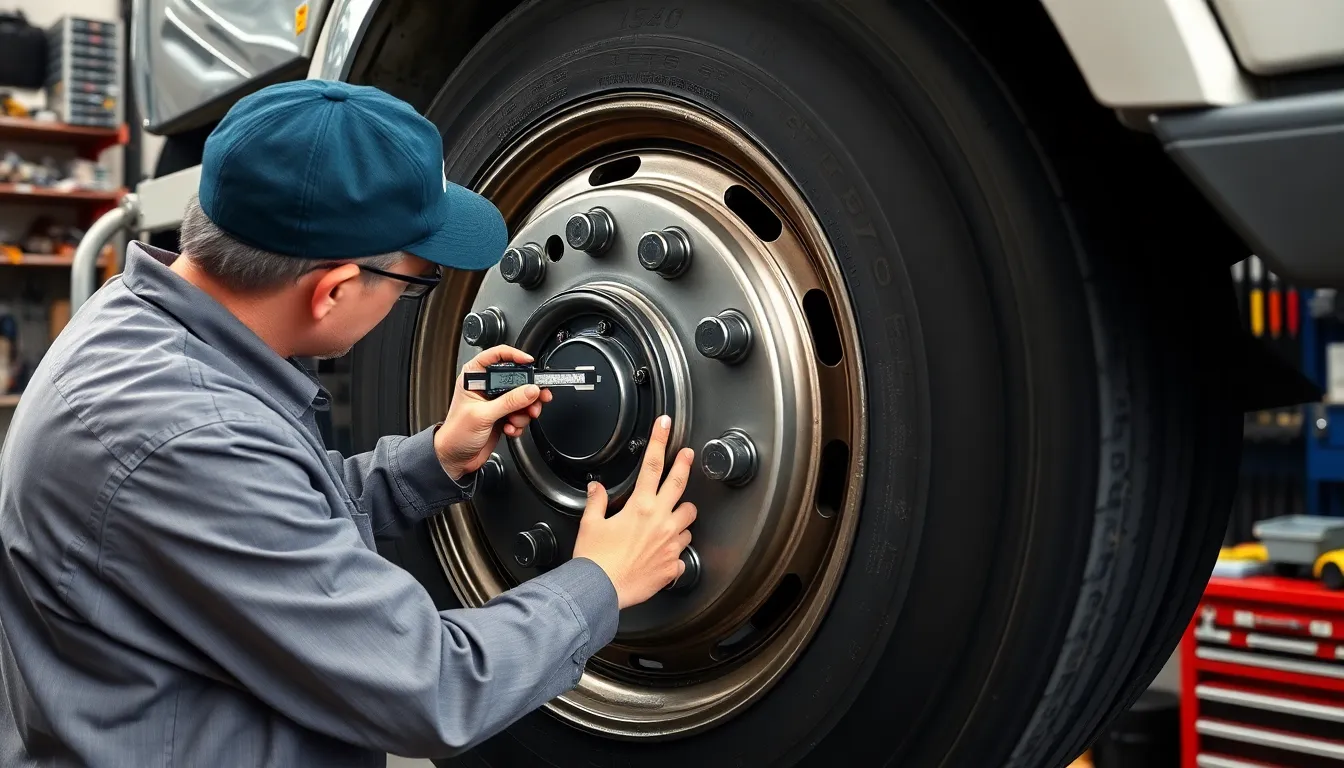
Measuring 8 and 10 lug patterns follows the same center-to-center methodology we use for other even-numbered configurations. These heavy duty patterns appear primarily on commercial vehicles, large trucks, and industrial equipment where extreme load bearing capacity is essential.
Count verification becomes critical with these larger patterns since the increased number of lug holes can create visual confusion. We always double check our count before proceeding with measurements to avoid costly fitment errors.
Opposite lug identification requires careful attention in 8 and 10 lug configurations. Each lug hole sits directly across from another lug hole, creating perfect alignment for our measurement process. We locate the opposing holes by drawing an imaginary line through the wheel’s center point.
Center-to-center measurement involves placing our measuring tool from the exact center of one lug hole to the exact center of the directly opposite hole. Digital calipers provide the most accurate readings for these larger diameter patterns, which typically range from 165mm to 285mm depending on the application.
| Lug Count | Common Measurements | Typical Applications |
|---|---|---|
| 8 lug | 170mm, 200mm, 210mm | Heavy duty trucks, commercial vehicles |
| 10 lug | 225mm, 250mm, 285mm | Industrial equipment, specialty vehicles |
Recording our measurements in the standard format becomes “8x170mm” or “10x225mm” where the first number represents lug count and the second shows bolt circle diameter. We always express measurements in millimeters for consistency with industry standards.
Verification techniques help confirm our readings accuracy. We can measure between adjacent lug holes and apply the mathematical formula exact to 8 or 10 lug patterns. This secondary measurement provides validation of our primary center-to-center reading.
Safety considerations increase with these heavy duty patterns since the vehicles using them operate under extreme conditions. Incorrect measurements can result in catastrophic wheel failure during high stress situations, making precision absolutely essential for proper fitment.
Common Wheel Lug Patterns by Vehicle Type
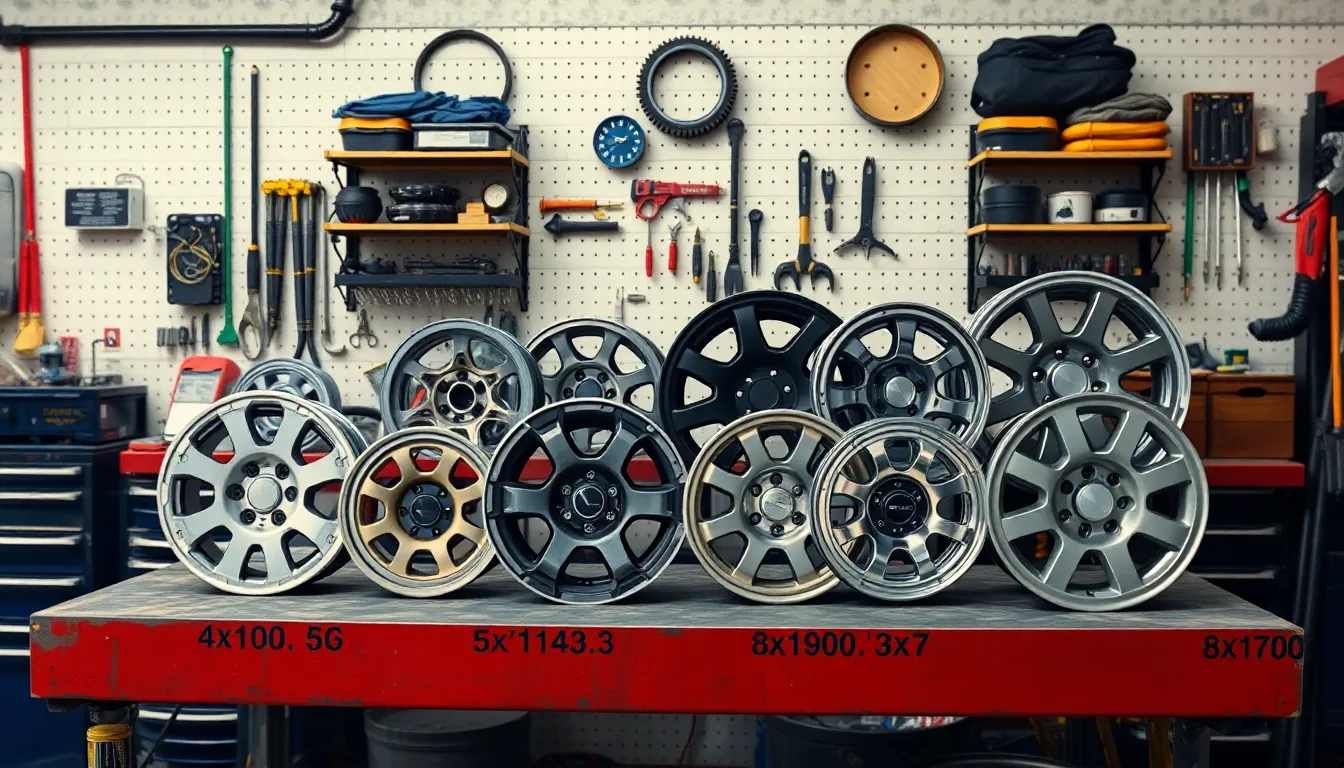
Automotive manufacturers design exact lug patterns for different vehicle categories based on weight requirements and performance characteristics. Understanding these standard configurations helps us identify compatible wheels during upgrades or replacements.
Passenger Cars and Light Trucks
Most passenger vehicles use standardized bolt patterns optimized for everyday driving conditions and moderate load capacities. 4×100 patterns appear frequently on compact cars and smaller sedans, where lightweight construction takes priority. 5×114.3 configurations dominate the mid-size passenger car market, providing enhanced stability through additional mounting points.
5×120 patterns serve luxury vehicles and performance cars that require superior wheel-to-hub connection strength. European manufacturers often specify 5×112 bolt circles for their vehicles, creating a distinct regional standard. Light trucks typically employ these same 5-lug configurations, though some models transition to 6-lug patterns when towing capacity increases beyond standard passenger car limits.
| Pattern Type | Common Applications | Typical Vehicles |
|---|---|---|
| 4×100 | Compact cars, economy vehicles | Honda Civic, Toyota Corolla |
| 5×114.3 | Mid-size cars, crossovers | Ford F-150, Honda Accord |
| 5×120 | Luxury sedans, performance cars | BMW 3 Series, Chevrolet Camaro |
| 5×112 | European vehicles | Audi A4, Mercedes C-Class |
Heavy Duty Trucks and Commercial Vehicles
Commercial applications demand robust lug patterns that distribute extreme loads across multiple mounting points. 6×139.7 patterns dominate pickup trucks and SUVs designed for heavy towing and off-road use. This configuration provides 50% more mounting points than 4-lug systems, significantly improving load distribution and wheel retention under stress.
8×165.1 and 8×170 patterns serve heavy-duty trucks where maximum strength becomes critical for safety and performance. These 8-lug configurations appear on vehicles with gross vehicle weight ratings exceeding 8,500 pounds. Commercial delivery trucks, construction vehicles, and large pickup trucks rely on these patterns to maintain wheel integrity under extreme operating conditions.
| Pattern Type | Load Capacity | Primary Applications |
|---|---|---|
| 6×139.7 | Medium duty | Pickup trucks, large SUVs |
| 8×165.1 | Heavy duty | Commercial trucks, fleet vehicles |
| 8×170 | Super duty | Construction trucks, heavy haulers |
Commercial vehicle manufacturers engineer these patterns with larger stud diameters and reinforced hub assemblies to handle continuous heavy-load operations. We recommend verifying both front and rear patterns on commercial vehicles, as some configurations use different bolt circles between axles for specialized load distribution requirements.
Tips for Accurate Measurements
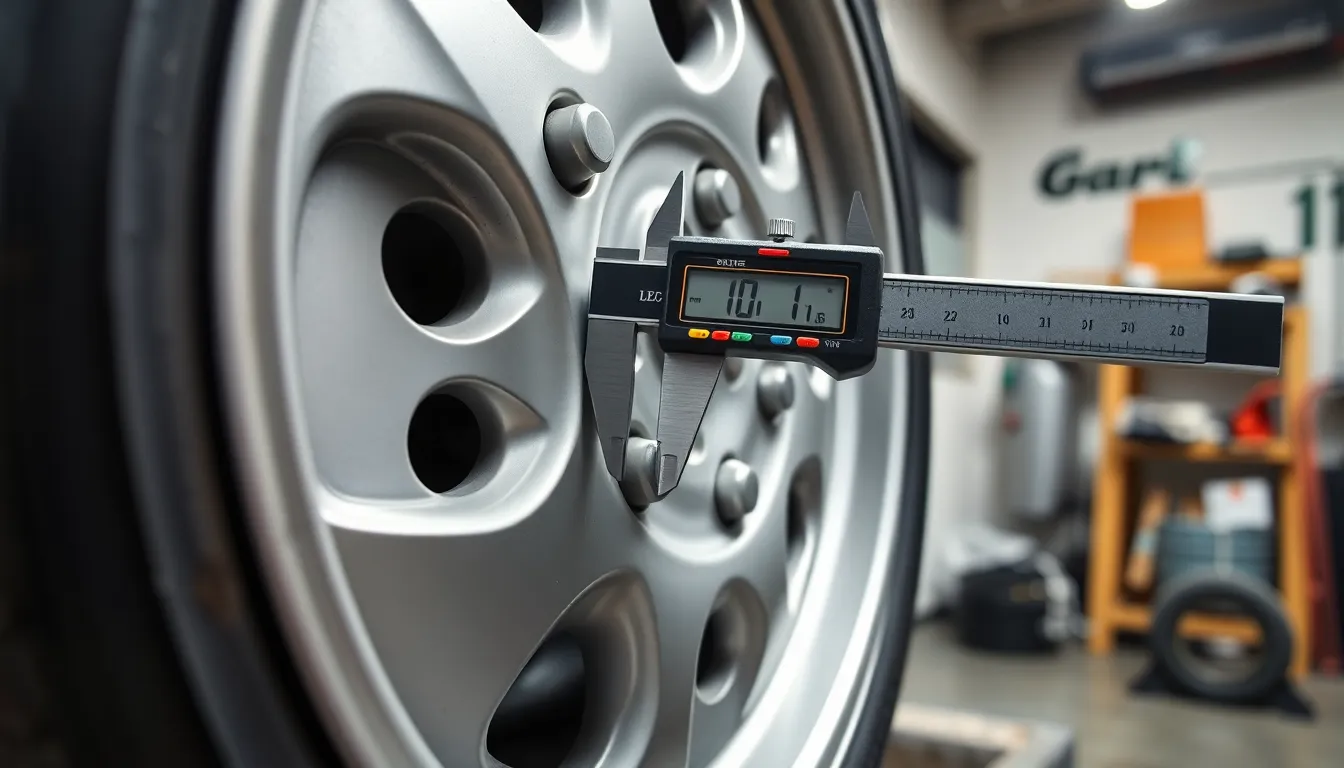
Precise measuring tools make the difference between successful wheel fitment and costly mistakes. Digital calipers provide the most reliable readings when measuring lug patterns, offering accuracy within 0.1 millimeters compared to standard rulers that can introduce measurement errors of 2-3 millimeters.
Clean lug holes before taking any measurements to ensure debris doesn’t affect your readings. Dirt, rust, or corrosion can add unwanted thickness that skews your measurements by several millimeters, leading to incorrect bolt pattern identification.
Double check your measurements using multiple methods to verify accuracy. Take the same measurement three times and compare results – consistent readings within 1 millimeter indicate reliable data, while variations suggest the need for remeasurement.
Proper lighting enhances measurement precision by allowing clear visibility of lug hole centers and measurement marks. Use a flashlight or work light to illuminate the wheel surface, eliminating shadows that can obscure measurement points.
Remove decorative caps or wheel covers that might obstruct access to lug holes. These accessories often hide the actual lug nuts and can prevent accurate counting or measuring of the bolt pattern.
Work on a stable, level surface when measuring wheels to maintain consistent positioning. Uneven surfaces can cause the wheel to shift during measurement, introducing errors in your bolt circle diameter calculations.
Record both the lug count and diameter measurement immediately after taking readings. Write down measurements like “5×114.3” to avoid confusion later, as mixing up these numbers can lead to purchasing incompatible wheels.
Cross reference your measured bolt pattern against manufacturer specifications when possible. Vehicle documentation or online databases can confirm your measurements and catch any calculation errors before wheel purchases.
What to Do if Your Measurements Don’t Match Standard Patterns

Encountering measurements that don’t align with standard wheel lug patterns creates confusion for vehicle owners attempting to upgrade their wheels. We recommend first double checking our measurement technique to ensure accuracy before considering alternative explanations.
Verify Measurement Accuracy
Digital calipers provide the most reliable measurements when standard patterns seem incorrect. Clean the lug holes thoroughly and remeasure from multiple angles to confirm our initial readings. Record each measurement separately and compare them for consistency across all attempts.
Cross Reference with Vehicle Specifications
OEM specifications from the vehicle manufacturer serve as the definitive source for bolt pattern information. Check the owner’s manual or contact the dealership to verify the correct lug pattern for our exact make, model, and year. Online databases like Wheel Size and TireRack.com also maintain comprehensive vehicle specification records.
Consider Custom or Modified Wheels
Previous owners may have installed aftermarket wheels with non standard patterns using wheel adapters or spacers. Examine the wheel hub area for signs of modification hardware between the wheel and vehicle mounting surface. These modifications can alter the effective bolt pattern measurements we obtain.
Consult Professional Wheel Specialists
Tire shops and wheel specialists possess specialized tools for measuring complex lug patterns accurately. Professional wheel fitment services can identify unusual patterns and recommend compatible wheel options. Many shops offer free measurement services when considering wheel purchases.
Account for Measurement Tolerances
Manufacturing tolerances can cause slight variations in standard patterns that affect our measurements. A 5×114.3 pattern might measure 114.1mm or 114.5mm due to normal production variances. Round our measurements to the nearest standard specification when differences fall within 0.5mm tolerance ranges.
Document Unusual Findings
Record any non standard measurements with photos and detailed notes for future reference. Create a measurement log that includes the vehicle’s VIN, wheel position, and multiple measurement attempts. This documentation helps professionals diagnose fitment issues and ensures consistency during wheel shopping.
Conclusion
Measuring your wheel lug pattern accurately ensures you’ll find wheels that fit perfectly and maintain your vehicle’s safety standards. We’ve covered the essential techniques for counting lugs and measuring bolt circle diameter across all common configurations.
Remember that precision matters when taking these measurements. Clean lug holes provide clearer readings while digital calipers deliver the most reliable results. Double-checking your measurements against manufacturer specifications prevents costly mistakes.
Whether you’re upgrading to aftermarket wheels or replacing damaged ones knowing your exact lug pattern saves time and eliminates guesswork. Armed with this knowledge you can confidently shop for wheels that’ll enhance both your vehicle’s performance and appearance while maintaining optimal safety standards.
Frequently Asked Questions
What is a wheel lug pattern and why is it important?
A wheel lug pattern represents the arrangement of bolt holes on your vehicle’s wheel hub and corresponding holes on the wheels. It consists of the number of bolt holes and the diameter of the circle passing through each hole’s center. Using the correct lug pattern is crucial for safety, as mismatched patterns can cause vibrations, uneven tire wear, compromised braking, and even wheel failure.
What tools do I need to measure my wheel lug pattern?
You’ll need a ruler or digital calipers (recommended for accuracy), access to your vehicle’s wheels, a bolt pattern guide for verification, proper lighting, safety equipment like gloves and safety glasses, and a clean cloth to remove debris from lug holes. Digital calipers provide the most reliable measurements for precise wheel fitment.
How do I count the lug nuts on my wheels?
Count all visible lug nuts on one wheel, typically ranging from 4-8 lugs depending on your vehicle type. Remove decorative caps if they obscure the view. Double-check your count to prevent errors. Most compact cars have 4 lugs, passenger cars have 5, pickup trucks have 6, and heavy-duty vehicles may have 8 lug nuts.
How do I measure even-numbered lug patterns (4, 6, or 8 lugs)?
For even-numbered patterns, measure the distance directly across the center from one lug hole to the opposite lug hole. This center-to-center measurement gives you the bolt circle diameter (BCD). For verification, you can also measure between adjacent lug holes and use a formula to calculate the BCD.
How do I measure a 5-lug pattern?
Since 5-lug patterns don’t have directly opposite holes, use the “skip-one” method. Measure from the center of one lug hole to the outer edge of the lug hole that’s two positions away. This measurement provides the bolt circle diameter. Digital calipers are recommended for accuracy with this measurement technique.
What are the most common lug patterns by vehicle type?
Common patterns include 4×100 for compact cars, 5×114.3 for mid-size passenger cars, 5×120 for luxury vehicles, 6×139.7 for pickup trucks, and 8×170 for heavy-duty commercial vehicles. The first number indicates lug count, while the second represents the bolt circle diameter in millimeters.
What should I do if my measurements don’t match standard patterns?
First, verify your measurement accuracy and double-check your technique. Cross-reference with OEM specifications and consider manufacturing tolerances. If measurements remain unusual, consult a professional wheel specialist who can help identify custom or modified patterns and recommend appropriate wheel options for your specific vehicle.
Can using the wrong lug pattern void my warranty?
Yes, using incorrect lug patterns can void both vehicle and aftermarket wheel warranties. It may also create liability issues in accidents and lead to denied insurance claims. Manufacturers design lug patterns with specific safety requirements, and deviating from these specifications can have serious legal and financial consequences.

